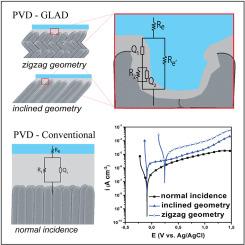纳米结构设计对闪烁角沉积法制备的 TiN 薄膜腐蚀性能的影响
IF 4.7
3区 材料科学
Q2 MATERIALS SCIENCE, MULTIDISCIPLINARY
引用次数: 0
摘要
本研究报告介绍了纳米结构设计对氮化钛(TiN)薄膜腐蚀性能的影响,该薄膜采用直流反应磁控溅射法,并使用滑动角沉积(GLAD)技术制备而成。主要目的是探索改变沉积几何形状如何影响氮化钛薄膜的生长设计和表面特征(保持氮/钛比率基本不变),并将这些影响与改变同一薄膜系统中的化学成分(氮/钛比率增加)所产生的影响进行比较。为此,我们制备了两组样品:第 1 组--样品以传统几何形状(正常生长)制备,氮含量变化(化学计量薄膜和非化学计量薄膜);第 2 组--样品以改良生长几何形状(倾斜和之字形,入射角增加)制备,化学计量几乎保持不变。结果显示,与第一组相比,第二组薄膜的表面孔隙率和粗糙度都有所增加,这表明沉积几何比成分变化对表面特性的影响更大。腐蚀研究表明,第 2 组制备的薄膜尽管孔隙率较高,但其开路电位(OCP)更稳定,其数值也比第 1 组的接近化学计量的 TiN0.92 参考薄膜(参考样品)更高。电化学阻抗光谱(EIS)证实了这些发现,与传统几何形状制备的薄膜(第 1 组样品)相比,采用倾斜和之字形几何形状制备的薄膜耐腐蚀性更低。这项研究表明,通过沉积几何形状定制纳米结构设计是优化 TiNx 腐蚀性能的一种可行方法,而无需改变其成分,从而推动了该薄膜响应技术的发展。本文章由计算机程序翻译,如有差异,请以英文原文为准。

The influence of the nanostructure design on the corrosion behaviour of TiN thin films prepared by glancing angle deposition
This study reports on the influence of nanostructure design on the corrosion behaviour of titanium nitride (TiN) thin films, prepared by DC reactive magnetron sputtering, using the Glancing Angle Deposition (GLAD) technique. The primary objective was to explore how modifying the deposition geometry affects the growth design and surface features of TiN films (keeping roughly constant the N/Ti ratio) and compare these effects with those produced by changing the chemical composition within the same thin film system (N/Ti increasing ratios). For this, two groups of samples were prepared: Group 1 – the samples were prepared in the conventional geometry (normal growth) with varied nitrogen content (stoichiometric and non-stoichiometric films) and; Group 2 – the samples were prepared with modified growth geometries (inclined and zigzag, with increasing incidence angles), keeping an almost unchanged stoichiometry. The results revealed increased surface porosity and roughness for Group 2 films compared to Group 1, demonstrating that deposition geometry can affect more significantly the surface characteristics than the composition variations. Corrosion studies indicated that the films prepared within Group 2, despite having higher porosity, showed a more stable open circuit potential (OCP) and nobler values than the reference close-stoichiometric TiN0.92 film (reference sample) from Group 1. However, potentiodynamic polarization curves suggested higher corrosion kinetics for Group 2 films, most likely due to their increased surface heterogeneities. Electrochemical impedance spectroscopy (EIS) confirmed these findings, showing lower corrosion resistance for films prepared with inclined and zigzag geometries, if compared to the films prepared in conventional geometry (Group 1 samples).
This study advances the current state of the art on this film's responses, by demonstrating that tailoring nanostructure design through deposition geometry offers a promising approach to optimize the corrosion behaviour of TiNx without the need to change its composition.
求助全文
通过发布文献求助,成功后即可免费获取论文全文。
去求助
来源期刊

Materials Chemistry and Physics
工程技术-材料科学:综合
CiteScore
8.70
自引率
4.30%
发文量
1515
审稿时长
69 days
期刊介绍:
Materials Chemistry and Physics is devoted to short communications, full-length research papers and feature articles on interrelationships among structure, properties, processing and performance of materials. The Editors welcome manuscripts on thin films, surface and interface science, materials degradation and reliability, metallurgy, semiconductors and optoelectronic materials, fine ceramics, magnetics, superconductors, specialty polymers, nano-materials and composite materials.
 求助内容:
求助内容: 应助结果提醒方式:
应助结果提醒方式:


